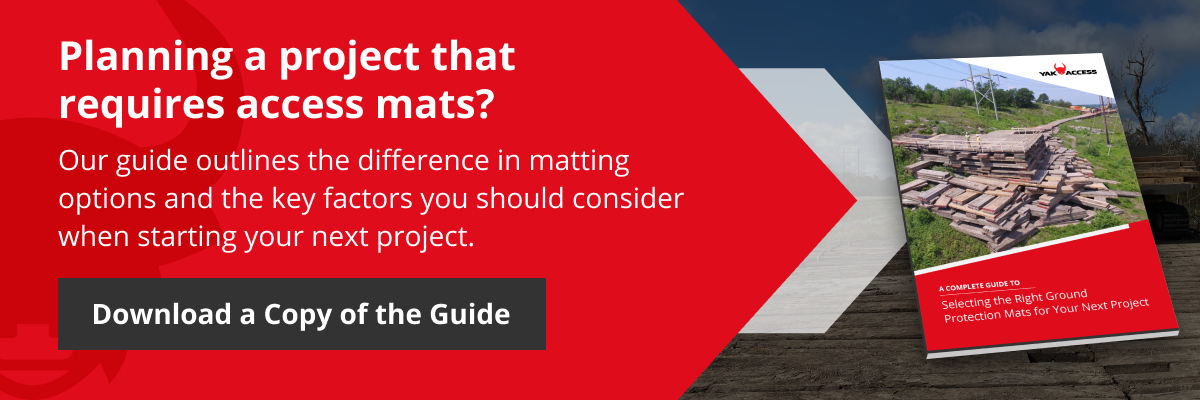Transporting heavy equipment to remote locations for construction or maintenance sometimes requires traversing delicate forested wetlands. These environmentally sensitive areas present both logistical and regulatory challenges that must be overcome for safe project completion and environmental compliance.
Can You Build on Swampy Land?
Wetland access is possible, and it’s often a critical component of a successful project. Building roads on swampy ground requires specialized equipment, deep knowledge of regulatory requirements, and the expertise to implement customized solutions. With all of these elements in place, you can build on swampy land with minimal impact.
Essential Considerations for Building Roads on Swampy Ground
When it’s necessary to build temporary roads through wetlands and you don’t have sound soil, several steps are required before people, materials, and heavy equipment can be transported across swampy ground.
Site Assessment
Because every wetland is different, a site assessment is necessary to create a customized plan. The site evaluation should include an assessment of:
-
Plants and wildlife that may be affected, including endangered and invasive species
-
Soil density and the potential impact of soil compaction
-
Hydrologic data such as tidal flows and drainage channels
-
Water depth and salt content
-
Stumps and other obstructions in the path
This data may be gathered from a combination of in-person site visits, drone or helicopter footage, amphibious vehicles, existing imagery, and other methods.
The team that performs this work, often a combination of civil engineers, regulatory professionals, and construction superintendents, must be qualified and experienced. Without the appropriate expertise to determine whether legal and regulatory restrictions allow access and how to overcome challenges with swampy terrain, the project can stall out before it even starts.
Planning
When creating a plan for wetland access, you need to factor in both the site assessment and the unique features of the project, including:
-
The length of the road
-
The size and weight of the equipment and materials being transported
-
Weather conditions
-
Staging and storage areas
-
The frequency of travel and duration of the project
From this information, a qualified planner can determine the best temporary road system to meet the load requirements with minimal impact on the environment.
Permitting
Once a plan has been developed, permits must be secured. Understanding the regulations and complying with them is important for avoiding fines or penalties, which also helps protect your company’s reputation. Local and federal regulations vary, so it’s important to understand which regulatory bodies have jurisdiction and what their individual requirements are. These could include:
-
Calculations for downward pressure of the temporary road
-
Methods for preventing the spread of invasive species
-
A plan for environmental restoration
Remember that the permitting process takes time and sometimes includes public comment periods, so factor this in when creating your project timeline.
Implementation
Installing a temporary road through swampy land can take many forms. Options for the temporary road include combinations of:
-
Geotextiles
-
Riprap and gravel
-
Wood mats
-
Specialized wetland systems
Installation methods depend on the materials being used but should always be performed by qualified professionals who understand the environmental regulations surrounding the project. When choosing a site access provider, it’s important to partner with a team that provides a range of solutions and not just a single product. Site access through swampy land is not uniform from beginning to end, so having various materials and installation methods at your fingertips is essential.
The emtek® Wetland Protection System
The emtek Wetland Protection System helps protect sensitive wetlands by distributing weight over a large area and floating on the vegetative layer to avoid impacting the root system. In fact, the downward pressure of a typical temporary road built using the emtek system has less than half the downward pressure of a human footprint. This dramatically reduces post-project restoration efforts, making it a proactive and cost-effective solution to wetland access.
Made from engineered wood, the emtek system also offers the advantage of precise engineering calculations. Unlike with timber products, the exact design specifications are known, allowing for the exact determination of maximum wheel and axle loads and downward pressure.
Because it is essentially floating, the emtek system does not impede the flow of water, which is critical for maintaining a wetland ecosystem. The temporary road can also rise and fall with the tides, allowing crews to work seamlessly throughout the day.
Site access through wetlands with the emtek Wetland Protection System is just one of the many solutions YAK ACCESS offers. Subscribe to our blog to learn more about access matting, project planning, site preparation, and every other aspect of safe site access.



